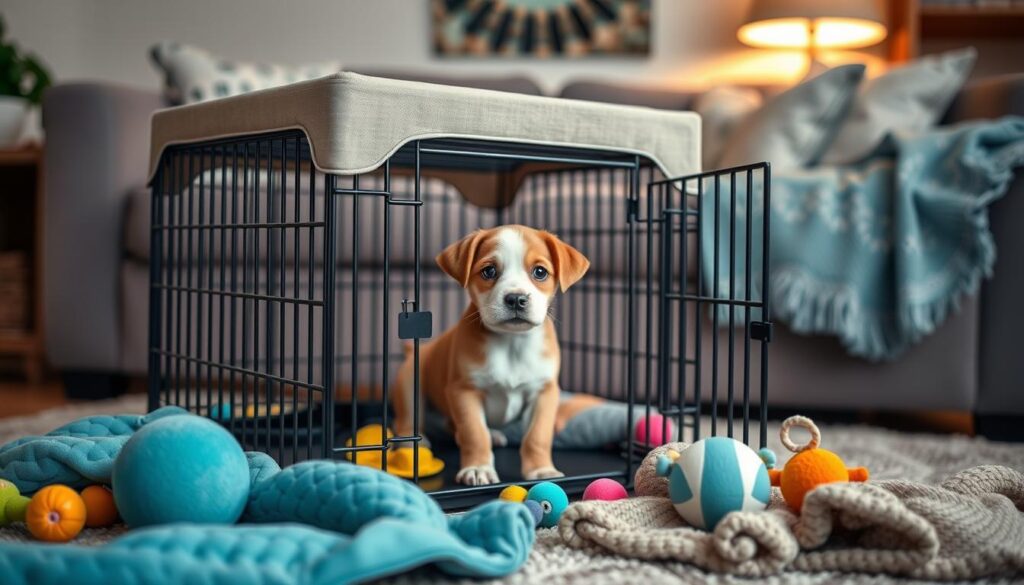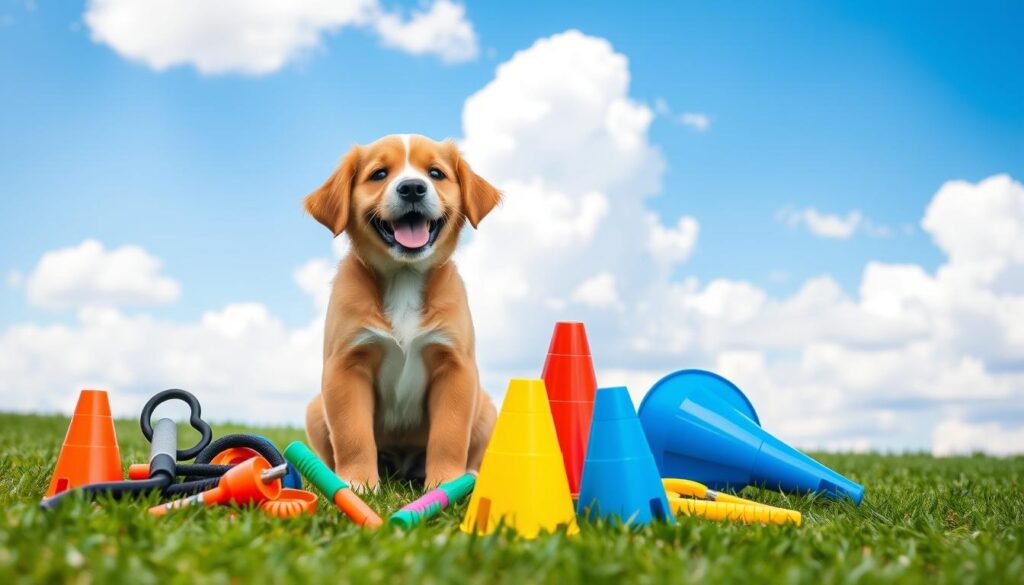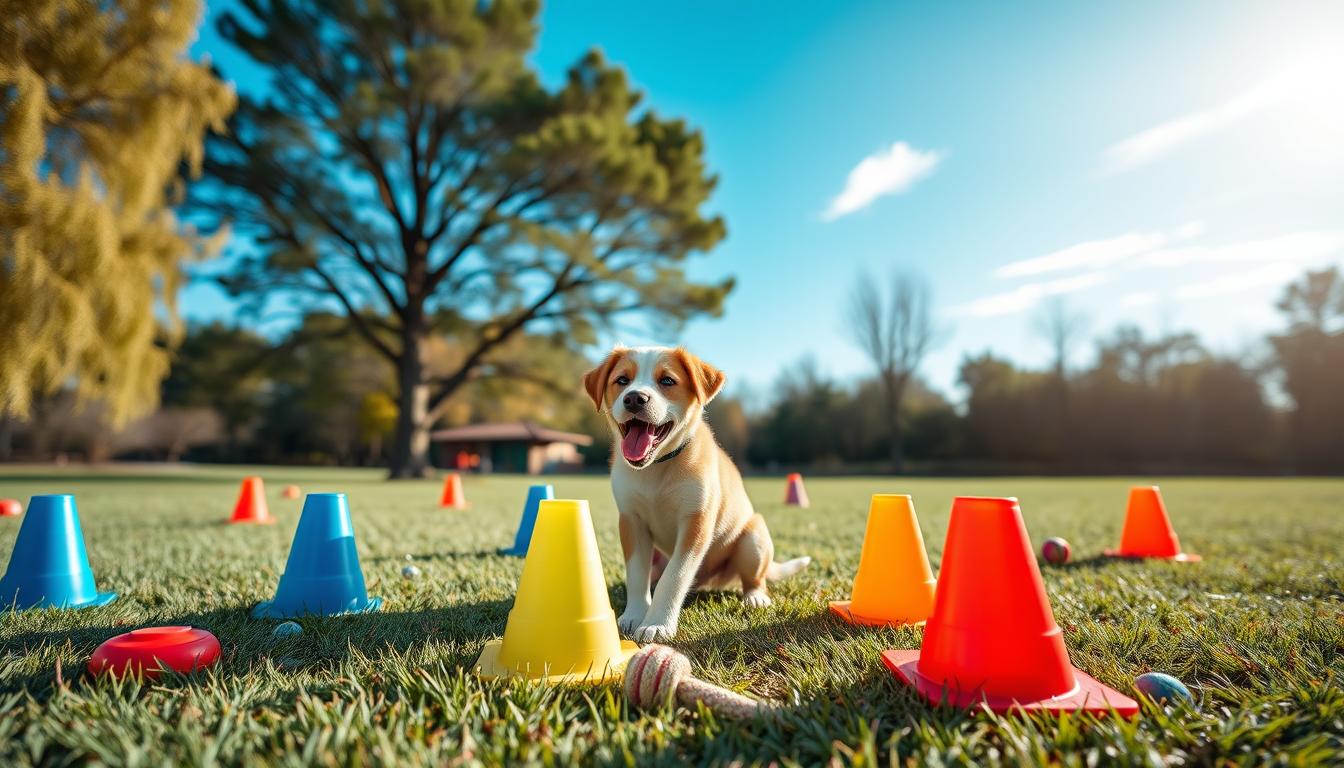How to train a new puppy. Getting a new puppy is thrilling, but it’s also a big responsibility. The first step is to start training early and use positive methods. This article will give you key tips for training your puppy. We’ll cover housebreaking, obedience, socialization, and how to handle common issues. Follow these tips to help your puppy grow up well-behaved and close to your family.
Ever thought about what are the most critical aspects of puppy training that can make or break your new canine companion’s development? In this detailed guide, we’ll explore the most important tips and methods. These will help your puppy become a well-behaved, confident, and loving friend.
Key Takeaways
- Early puppy training is crucial for establishing good habits and a strong bond with your pet.
- Positive reinforcement training is the most effective method for teaching your puppy new behaviors.
- Proper socialization before 16 weeks of age helps your puppy become a confident and well-adjusted adult dog.
- Crate training and housebreaking are essential for creating a stress-free environment for both you and your puppy.
- Addressing puppy biting and other common behavior issues early on can prevent future problems.
The Importance of Early Puppy Training
As a new puppy parent, it’s key to grasp the importance of early training and socialization. Puppies learn a lot, soak up their surroundings, and interact with others. Early training with positive reinforcement helps them develop good habits and grow into confident dogs.
Establishing Good Habits from the Start
Start training your puppy around 8 weeks old. They are most open to learning at this age. Teach them basic commands like “sit,” “stay,” and “come” early. This helps them avoid bad habits later on.
The Benefits of Positive Reinforcement Training
Positive reinforcement is the best way to train puppies. It rewards good behavior with treats and praise. This method avoids punishment, which can make dogs fearful and anxious.
“Positive reinforcement training is the most effective and humane way to train a puppy. It helps establish a strong bond between the owner and the pet, while also encouraging good behavior.”
Putting your puppy in a training program is very helpful. It offers a supportive learning space, tackles problem behaviors early, and strengthens your bond with your puppy.
Prepare Your Home for a New Puppy
Getting a new puppy is thrilling, but you must prepare your home first. Make sure your living space is puppy-proof. Set up areas for your puppy to sleep, play, and go potty.
Choose a safe spot for your puppy when you can’t watch them, like a gated room or puppy pen. This keeps accidents and damage to your things down. Get everything you need, like a comfy crate, soft bedding, fun toys, and puppy-safe chew items.
Make a new puppy checklist to make sure you’re ready. Pick spots for your puppy’s food and water bowls and a potty area. This helps start a good routine early on.
| Essential Puppy Supplies | Quantity |
|---|---|
| Crate | 1 |
| Bedding | 1-2 |
| Toys | 3-5 |
| Puppy-Safe Chew Items | 2-3 |
| Food and Water Bowls | 1 set |
By puppy-proofing your home and getting the right supplies, you’ll help your new puppy adjust well.
Potty Training Your Puppy
Potty training is key to raising a well-behaved puppy. A consistent puppy potty training schedule and knowing when your pup needs to go are crucial. With patience, positive feedback, and a routine, your puppy will learn to go potty outside.
Establishing a Consistent Routine
Puppies love routine. Create a puppy potty training schedule that fits your pup’s life. Take them out often, after meals, naps, and play. Give treats and praise when they go potty outside. Don’t scold for accidents, as it can slow down training.
Recognizing Your Puppy’s Potty Signals
Watch for signs like sniffing, circling, or squatting. These mean your puppy needs to go. Quick action and taking them outside helps them learn good habits.
Puppy potty training needs time and regular effort. A clear routine and knowing your pup’s needs will help them become a well-trained pet.
“Consistency in training is essential, as declaring victory too soon may lead to regression in house training progress.”
Crate Training Your New Puppy
Crate training is key for house training and giving your puppy a safe, cozy spot. It makes them feel secure when you can’t watch them. This is especially true for new puppies.
Start by feeding your puppy in the crate and giving them treats and toys. This makes the crate a positive place. Slowly increase the crate time, making sure it’s always a good experience.
At first, put the crate next to your bed to help with separation anxiety. As your puppy gets used to it, move the crate to its final spot. Crate training helps with house training and keeps your puppy safe when you’re not around.
- Wire crates are cooler and easier to clean than plastic ones, but may not feel as cozy for your puppy.
- Having multiple soft beds for your puppy’s crate is recommended, with one in the wash and one in the crate.
- Gradually increase the time your puppy spends in the crate, starting with 1 minute and working up to 4+ hours.
When you leave, start with short times and lots of treats. The first night might be tough, with crying. But with patience and positive feedback, your puppy will love their crate.
“Crate training can be beneficial for house training, chew training, car travel, recovery from surgery, and stays at the vet and groomer.”
Crate training is crucial for a well-adjusted puppy. It creates a safe, cozy space and helps with house training and more.

Preventing and Addressing Puppy Biting
Puppy biting is common as they explore the world with their teeth. It’s important to give them chew toys and stop them from biting hands and bodies.
If your puppy bites, stop playtime by walking away or using a timeout. Redirect their attention to chew toys or treats. Praise and reward them for chewing the right things. Puppies usually stop biting as they lose their baby teeth, but training is key.
Puppies bite due to teething and play. Training them consistently helps them grow out of this habit. Positive reinforcement teaches them not to bite is good.
Redirecting their behavior to toys helps prevent biting. Teaching them to chew on the right things is crucial. If biting doesn’t stop, you might need professional help.
Puppies use their mouths to play and communicate. They learn not to bite too hard from their litter and mother. Puppies that don’t stay with their family early on may have biting problems.
Dog play helps puppies learn to use their mouths right. Exercise and stimulation are important to stop puppy biting.
| Puppy Biting Strategies | Benefits |
|---|---|
| Provide Appropriate Chew Toys | Redirects biting to acceptable items |
| Positive Reinforcement Training | Encourages desirable behaviors |
| Consistent Timeout and Redirection | Teaches puppies not to bite |
| Professional Training Assistance | Addresses persistent or escalating biting |
how to train a new puppy
Getting a new puppy is thrilling, but it also means you must train them. Start training early, around 8 weeks old, to build good habits. Use positive methods to teach them sit, stay, and come.
Training should be short, about 5 minutes, and done often. Be patient and always use the same commands and signals. Also, introduce your puppy to new places and things slowly.
- Start training as early as 8 weeks old
- Keep training sessions short, around 5 minutes
- Use positive reinforcement techniques
- Be consistent with commands and hand signals
- Gradually expose your puppy to new environments
Learning these basic puppy training commands is key to a well-behaved dog. Training never stops, and your puppy will keep learning for 2-3 years. With patience and consistency, you can train a new puppy to be a loving, well-behaved friend.
| Puppy Training Tips | Benefits |
|---|---|
| Start training early, around 8 weeks old | Establishes good habits and builds a strong foundation |
| Use positive reinforcement techniques | Encourages desired behaviors and builds trust |
| Keep training sessions short and consistent | Maintains your puppy’s attention and helps them learn |
| Gradually expose your puppy to new environments | Helps them generalize their training and become well-adjusted |

“Consistency is the key to successful puppy training. With patience and dedication, you can help your new furry friend become a well-behaved companion.”
Socializing Your Puppy
The Importance of Early Socialization
Socializing your new puppy is key for their growth and happiness. Between 3 and 12 weeks, they need to meet many people, animals, and places in a good way. This helps them be brave and not scared as they get older.
You should socialize your puppy often, at least two to three times a week, until they’re 6 months old. It’s best to start before they’re 16 weeks old, after they’ve had their first shots and deworming. If you wait too long, they might get scared or anxious as adults.
Puppy socialization classes are a great way to introduce your puppy to new things. These classes last four to six weeks. They teach your puppy to be confident and well-behaved through positive training.
Being consistent is important when socializing your puppy. Start with small steps and watch for signs of stress. With patience and a positive attitude, your puppy will grow into a happy, confident friend.
Leash Training Your Puppy
Teaching your puppy to walk on a leash is crucial. Start by letting them get used to the collar or harness indoors. Give them treats and praise for their efforts. When they’re comfortable, begin walking them in a safe area.
Keep training sessions short and fun. Use rewards to help them walk calmly beside you. This makes the learning process enjoyable for both of you.
As your puppy gets better, you can take them to new places. But always keep them on a leash until they’re fully trained. About 90% of puppies need leash training, and it usually takes 2-4 weeks.
Being patient and consistent is key. Positive reinforcement works well. Use treats to encourage good behavior, starting with one treat for every three steps. Gradually give fewer treats as they learn.
Training sessions should last 10-15 minutes. This is long enough to keep your puppy’s attention. With practice, your puppy will learn to walk nicely by your side. This way, you can both enjoy safe and fun outdoor trips together.





